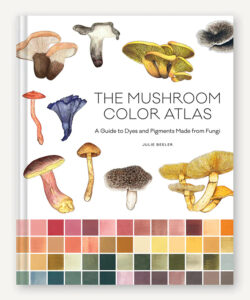SDA Book Club: The Mushroom Color Atlas reviewed by Lauren Sinner
January 10, 2025
The Mushroom Color Atlas: A Guide to Dyes and Pigments Made from Fungi by Julie Beeler

As someone who is well versed in natural dyeing, mushroom dyes and pigments are still such a wonder and mystery to me. Every time I’ve talked with author Julie Beeler about mushroom dyeing, it opens up a whole new world of possibilities—from harvesting and processing, to color palettes and application. I am honored to get to review her book, The Mushroom Color Atlas, as our first entry into the 2025 SDA Book Club!
One thing you’ll notice right away is the sheer quality and weight of the book. This is not a simple at-a-glance introduction to mushroom dyeing, but rather an in-depth look into the years of research that Julie has been doing. The Mushroom Color Atlas features stunning illustrations that are predominately black and white, but eventually become colorful as the book progresses. This in contrast to the colors of the dye samples, really makes the shape and features of the individual mushroom types stand out.
As a mushroom novice myself (both with foraging and dyeing) this book was amazing to read through, but a lot to digest. The way that color is extracted from a mushroom is quite a bit different than a plant, and wrapping my head around making lakes was completely new. One critique I have of The Mushroom Color Atlas is I wish more common names were used in the beginning, since I’m even more unfamiliar with the scientific names. There is possibly a design or teaching justification for them not being used, but I’m unsure of the reason. The common names were eventually used later in Section II, Mushrooms, but I would have liked to see them a little bit earlier.
The book is broken down into three main sections: Colors, Mushrooms, and Process. The Colors section features the mushroom types and basic notes used to create red, orange, yellow, green, blue, and purple dyes/pigments. The Mushrooms Section takes up the majority of the book (pages 98–230), and breaks down the different types of mushrooms, their structure, color palette, and dye/pigment preparations. This part of the book is incredibly in-depth and well-researched. I really appreciated how detailed the color options were for each mushroom—taking into account things like mordant, fiber type, and conditions/parts of the mushrooms. The final section, Process, goes over the equipment, preparation, steps, and more that goes into taking mushrooms and extracting their color. A lot of this section overlaps with other natural dye books I’ve read, but also goes into making watercolors, paints, and pigments, as well as the uniqueness of mushroom dyeing.
Overall, The Mushroom Color Atlas is a beautiful book, and the amount of care and research Julie put into it is incredibly apparent. If you’re experienced with natural dyes and want to push yourself to expand that world of knowledge, or if you live somewhere with a large mycelial community, I would heavily recommend this book!
–Lauren Sinner, SDA Managing Editor
- Publisher: Chronicle Books (buy it here)
- Date: September 2024
- ISBN: 9781797228457
- If you’ve read this book, leave a comment and let us know what you think!
- Check out this past SDA Blog Interview: Julie Beeler’s Mushroom Color Atlas
Do you have a recommendation for a recent fiber-related book you think should be included in SDA’s Book Club? Email SDA’s Managing Editor, Lauren Sinner, to let her know!
